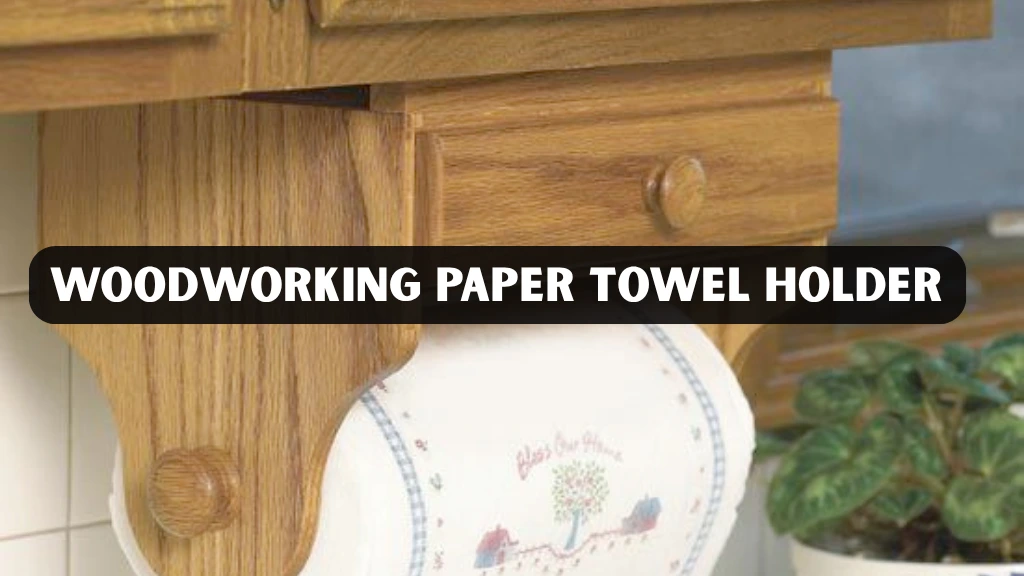A well-crafted paper towel holder is not only functional but also a wonderful way to showcase woodworking skills. Whether you are a beginner or an experienced woodworker, creating a personalized holder is a rewarding project that combines creativity, practicality, and craftsmanship. In this guide, you will find detailed instructions on selecting the right materials and tools, step-by-step assembly, finishing techniques, and tips to make your project both durable and visually appealing.
Making a holder yourself allows you to practice essential woodworking skills, including cutting, drilling, sanding, and finishing. The project also offers an opportunity to experiment with lathe work, creating a unique decorative rod that elevates the design. By the end of this project, you will have a functional item that complements your kitchen, workshop, or craft space while reflecting your personal style.
Why Make Your Own Paper Towel Holder
Creating your own holder provides several advantages over purchasing a ready-made product. One of the main benefits is customization. You can choose the type of wood, finish, and design style to perfectly suit your space and décor. Making it yourself also tends to be more cost-effective, especially when you already have the tools or can repurpose leftover wood from previous projects.
Beyond cost and customization, building a holder is an excellent learning experience. It allows you to refine your woodworking techniques while experimenting with different designs. You can try various lathe turning methods to create decorative elements, practice precise cutting, and master finishing methods that give your project a professional look. Additionally, homemade holders make unique and thoughtful gifts for family, friends, or fellow woodworking enthusiasts. A project of this nature not only provides a functional item but also serves as a tangible demonstration of skill and creativity.
Materials Needed
To build a high-quality holder, it is important to gather all the materials and tools before starting. Select a hardwood such as oak, maple, or walnut for durability and a polished appearance. Softer woods like pine or poplar can also be used for a lighter, simpler design. Fasteners are required for assembly, so plan to use screws and wood glue to ensure stability and strength.
For finishing, you will need sandpaper ranging from 120 to 220 grit, as well as wood stain, paint, or varnish to achieve the desired look. A lathe can be used for turning the rod or decorative elements, although it is optional if you prefer to use a pre-made dowel. Other essential tools include a saw for cutting the wood, a drill with bits for creating pilot holes, measuring tape or ruler, clamps for holding pieces in place while gluing, and a screwdriver. Preparing all materials and tools in advance ensures a smooth and efficient workflow throughout the project.
Types of Woodworking Paper Towel Holder
When designing your holder, it is useful to consider different styles. Freestanding holders are portable, allowing you to place them wherever they are most convenient. They work well on countertops or in workshop spaces. Wall-mounted holders, on the other hand, save counter space and remain fixed in one location. Choosing the right style depends on your personal preference, the intended location, and the design of your space.
Holders can also be classified as classic or decorative. Classic holders typically consist of a simple base and a vertical rod, providing a clean, functional design. Decorative holders offer more elaborate features, such as lathe-turned rods, carved patterns, or inlays, which add elegance and showcase woodworking skill. By selecting a design that matches both function and aesthetic preference, you can create a holder that is practical, stylish, and uniquely yours.
Step by Step Instructions
Building a woodworking paper towel holder can be broken down into four main stages: preparing the wood, turning components on the lathe, assembling the base and rod, and finishing the project.
Preparing the Wood
The first step involves measuring and cutting the wood to the desired dimensions. The base should typically measure between eight to ten inches in width and ten to twelve inches in length, depending on the size of the paper towel roll you plan to use. After cutting, all surfaces and edges should be sanded to remove splinters and rough spots. Start with 120-grit sandpaper for initial smoothing and finish with 220-grit sandpaper for a polished surface. This preparation is essential for a professional appearance and ensures that the finished product is safe and comfortable to handle.
Turning Components on the Lathe
If you choose to incorporate decorative elements, a lathe can be used to turn the central rod or accent pieces. Secure the wood properly on the lathe and turn it slowly to shape it into a smooth cylinder or to add grooves and patterns. Safety is crucial during this step; always wear protective goggles and follow recommended lathe safety procedures. For those without a lathe, a pre-made wooden dowel can serve as an effective substitute, allowing the project to be completed without specialized equipment.
Assembling the Base and Rod
After the components are prepared, it is time to assemble the holder. Position the rod vertically in the center of the base and drill pilot holes to prevent the wood from splitting when inserting screws. Use screws and wood glue to secure the rod firmly. Take care to ensure that the rod is perfectly vertical, as misalignment can affect the stability and function of the holder. Proper assembly guarantees that the holder will remain sturdy during everyday use and maintain its aesthetic appeal.
Finishing Touches
Finishing is the final stage and involves sanding the entire holder once more to ensure smooth surfaces. Apply your chosen wood stain, varnish, or paint to enhance the appearance and protect the wood from moisture and wear. Optional decorative touches can include grooves, carved patterns, or inlays, allowing for a unique, personalized design. Allow finishes to dry completely before using the holder to ensure durability and maintain the quality of the wood over time
Tips for Customization
There are many ways to customize a woodworking paper towel holder to match your personal style. You can combine different wood types to create contrasting visual effects, such as pairing a walnut rod with an oak base. Experimenting with turned shapes or carved patterns adds decorative appeal, giving the holder a unique and professional look. These creative touches allow you to showcase your woodworking skills while making the piece visually striking.
Functionality can also be enhanced through thoughtful adjustments. Changing the height of the rod enables the holder to accommodate larger paper towel rolls, while adding a weighted base improves stability. Installing non-slip pads on the bottom helps prevent movement and protects the surfaces it rests on. By combining aesthetic customization with practical improvements, you rpaper towel holder can be both beautiful and highly functional.
Common Mistakes to Avoid
Certain mistakes are common among woodworkers making paper towel holders. Misalignment of the rod is a frequent problem that can cause rolls to tip. Over-tightening screws without drilling pilot holes may result in split wood. Skipping sanding steps can leave rough surfaces that are unpleasant to touch and reduce the quality of finishes. Ignoring lathe safety or rushing the finishing process can also compromise both the safety and durability of the project. Being mindful of these potential errors helps ensure a successful outcome and a holder that is both safe and attractive.
Real-World Case Study
Sarah, an experienced woodworker, created her own woodworking paper towel holder for her kitchen. She selected maple for the base and a lathe-turned oak rod for the centerpiece. The base was carefully measured and cut, while the rod was shaped using a lathe to create elegant grooves. Pilot holes were drilled, and the rod was secured with screws and wood glue. After assembly, the entire holder was sanded and finished with a clear varnish, highlighting the natural grain of the wood.
The finished holder was both functional and decorative, serving as a centerpiece for the kitchen counter. Sarah’s project demonstrates how careful planning, proper technique, and attention to finishing details can transform a simple DIY project into a professional-quality woodworking piece.
Conclusion
Creating a woodworking paper towel holder is a practical and rewarding project that blends skill, creativity, and functionality. By choosing high-quality materials, carefully following step-by-step instructions, and applying proper finishing techniques, you can craft a durable and visually appealing holder that enhances any kitchen or workspace. Even smaller projects like this give woodworkers the opportunity to practice essential skills, explore different design elements, and produce personalized items that reflect their craftsmanship.
This project demonstrates how careful planning, attention to detail, and dedication to quality can turn a simple idea into a professional-looking product. Whether you are making it for personal use or as a thoughtful gift, a custom paper towel holder showcases both style and skill. Starting this project allows you to apply your creativity, experiment with unique touches, and share the finished piece with the woodworking community..
FAQs
Can beginners make a woodworking paper towel holder?
Yes, beginners can create this project with basic tools and guidance. Step-by-step instructions make it accessible even for those new to woodworking.
What type of wood is best for durability?
Hardwoods like oak, maple, or walnut are strong and long-lasting. Softer woods like pine are suitable for lighter, simpler holders.
Do I need a lathe to complete this project?
No, a lathe is optional. It allows for decorative turning on the rod, but pre-made dowels can also be used effectively.
How long does it take to build?
Depending on complexity, the project takes between 2 and 5 hours for beginners. Experienced woodworkers may complete it faster.
Can I paint or stain the holder?
Yes, sanding and proper finishing are essential for optimal results. Use varnish or sealant for durability.




